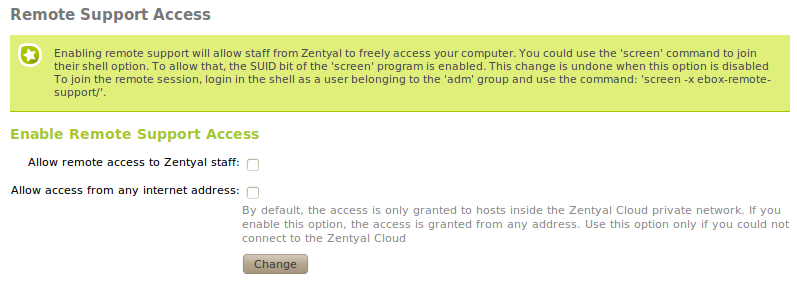Support tools¶
About Zentyal support¶
Zentyal servers have some tools that can ease the delivery of technical support. The main ones will be described in this chapter.
Moreover, you can check the commercial support offering in Zentyal’s web site [1].
| [1] | http://www.zentyal.com/en/services/support/ |
Configuration report¶
The configuration report is an archive which contains your Zentyal configuration and a good deal of information about your system. By providing it when requiring technical support, you can save time as it will probably contain the information required by the support engineers.
There are two ways to generate the report:
- In the web interface go to System ‣ Configuration Report; click in the button for generate the report; when the report is ready it will be downloaded by your browser.
- Through the command line run the command /usr/share/ebox/configuration-report. When the report is generated the command will show you its location in the file system.
Remote access support¶
In some difficult cases, if your work environment permits it, it would be helpful to let a support engineer access directly to your Zentyal server.
The module Zentyal Cloud Client provides a feature to streamline this procedure. The remote access is done using ssh and public key encryption [2] so that it is not need to share any password.
| [2] | You can find more information on public key encription on chapter Certification authority (CA). |
Moreover, access is only accessible through Zentyal Cloud’s virtual private network, guaranteeing the security of the whole support process. For situations where the server could not be subscribed to Cloud or the virtual private network is not working properly, there exists an option to allow access from any Internet address.
The access will only be available as long as this feature is enabled so is recommended to turn it on only for the time it is necessary.
Before enabling it you must meet these prerequisites:
- You server must be either subscribed to Zentyal Cloud or be visible on the Internet, that is, it must accept connections from external networks.
- Service sshd must be running.
- If you are using a firewall, it must be configured to allow incoming ssh connections (this connections normally use TCP port 22).
- In configuration of the sshd service, option PubkeyAuthentication must be enabled, which is the default configuration.
To enable this feature, go to General ‣ Remote access support and check the Allow remote access to Zentyal staff control, then save changes as usual.
If you want to allow access from the Internet, check also the option Allow access from any Internet address. In this case you should give your Internet address to the support engineer and make sure that ssh access is allowed from the Internet.
Once you have provided the server’s Internet address to the support engineer, he will be able to login in your server as long as this feature is enabled.
You can use the screen program to see in real time the support’s session; this could be useful to share information.
To be able to do this you must be logged with a user belonging to the group adm. The user created during the installation process fulfills this requirement. Once logged in, you can join the session with this command:
screen -x ebox-remote-support/
By default you can only see the session; if you need to write in the command line and execute programs you should ask the support engineer to grant you the right permissions.

